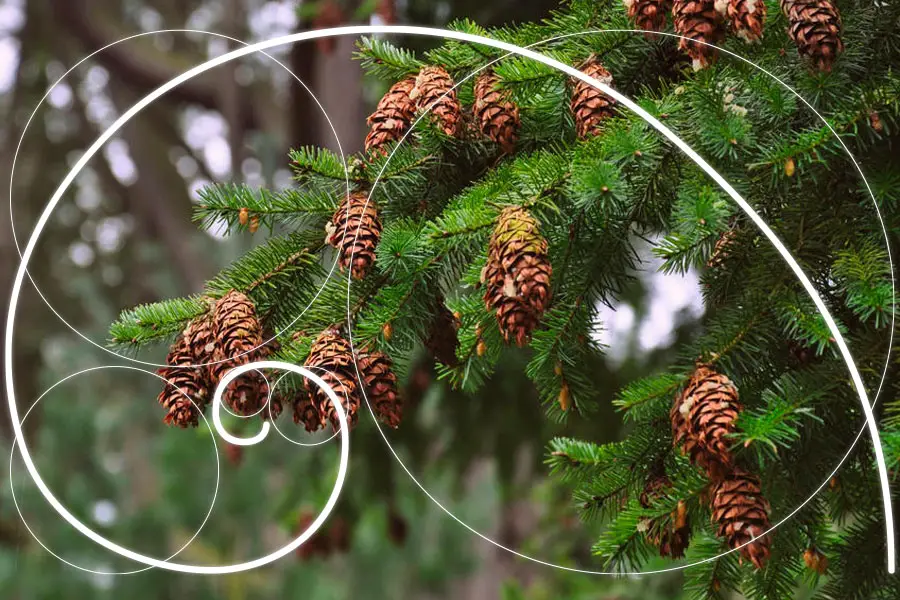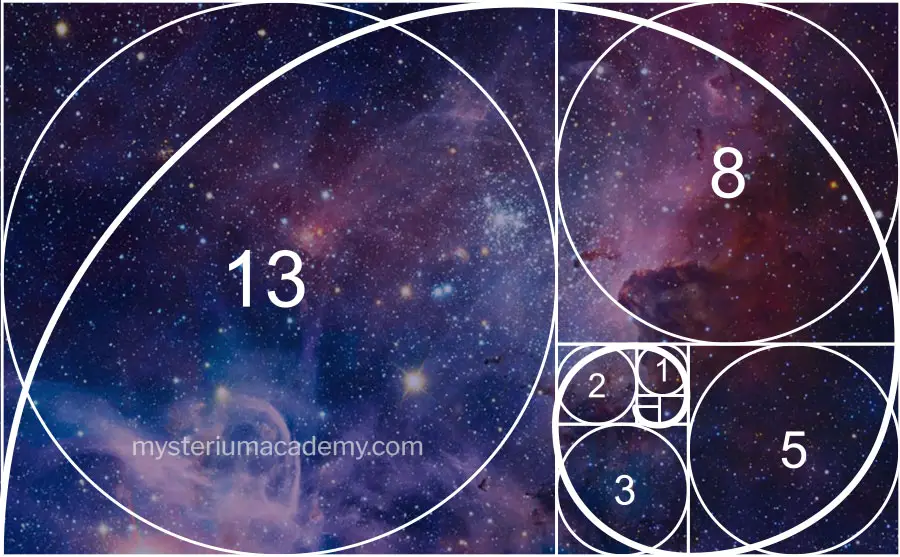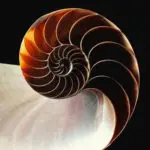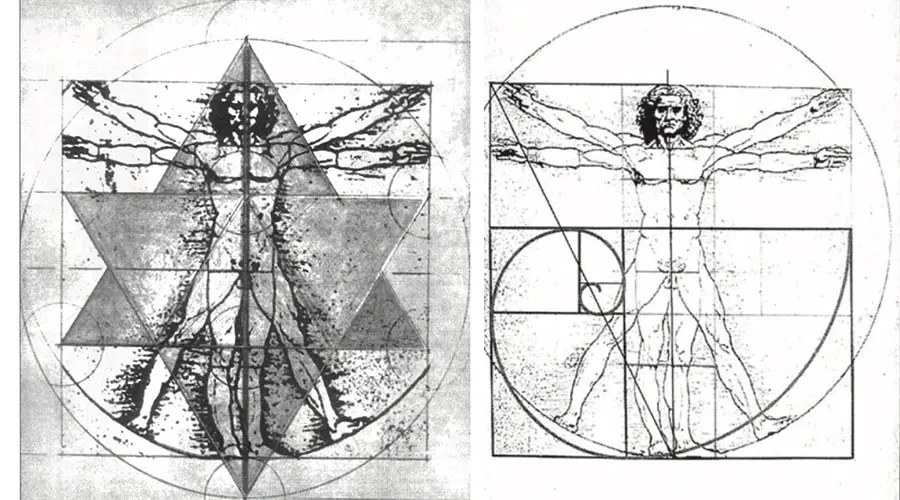The eye-catching and beautiful spiral is often seen in nature, and is of great interest to those who study sacred geometry. In this article we are going to look at the question: How are spirals used in sacred geometry?
The spiral is seen in Sacred Geometry as an important pattern in the creation process. It is related to the Fibonacci sequence, which is a series of numbers of progressively growing numbers, present in the patterns of flowers, the scales of pinecones, and many other places in nature.
The Fibonacci sequence was first observed by an Italian monk in the 1200s, and when you chart it out on paper, it forms a spiral pattern. This will all make sense in a moment.

The Fibonacci Sequence and the Spiral
The Fibonacci sequence is created by taking the previous two numbers in a sequence of numbers and adding them to get the next number in the sequence. 1 plus 1 equals 2. Add 2 to o1e and you get 3. Then add 2 plus 3 for 5. And on and on. So 3+5=8, 5+8=13. 5, 8, 13, as well as 21 are Fibonacci numbers.
When you look at the Fibonacci and chart a line through the growing numbers, you get a spiral. It’s a bit of a tricky concept, but check out the image below, and it will make sense:

Sacred Geometry is all about the shapes and patterns of the creation process. All sacred geometry is contained within the flower of life shape. Within the flower of life there are many other shapes, including the Vesica Piscis, which is simply two overlapping circles, and it progresses through the Seed of Life, the Egg of Life, and the Fruit of Life shapes. You can read more about the Flower of Life here.
This series of shapes describes the creation process, which is expressed in the cycle of plants such as fruit trees. The tree produces a flower, which then turns into a fruit. The fruit contains the seed which falls to the ground and becomes another tree.
The Fibonacci spiral is another way in which nature expresses the patterns of creation. It is found throughout nature.

Examples of the Fibonacci Sequence in Nature
 Nautilus Shells
Nautilus Shells
The nautilus shell is a wonderful example because it’s particular expression of the sequence also displays the logarithmic spiral shape of the Fibonacci sequence.
 Buttercups
Buttercups
One of the most famous examples of the Fibonacci sequence in nature include the five daisy buttercup. The famous sequence is also expressed in the angles of the petals, which are each at different angles, enabling maximum possible exposure to sunlight.
 Pine Cones
Pine Cones
The number of scales on a pine cone contains the Fibonacci sequence. If you count the scales going to the left and then count the line of scales going to the right, they will be Fibonacci numbers, either five and eight, or sometimes eight and thirteen.
 Spiral Galaxies
Spiral Galaxies
Demonstration the power of the law of correspondence, from the seven laws of alchemy (which you can read more about here), the Fibonacci sequence is also expressed on the massive scale of galaxies. The Milky Way has arms that form beautiful spiral patterns.
The Fibonacci Sequence was Discovered by Leonardo Bonacci
Although it was actually known about in ancient Greece, an Italian mathematician from Pisa discovered it in 1202. Bonacci was a monastic, who spent much of his time meditating, and walking in nature. He began to discover numerical patterns in flower petals and leaves. For example, lilies and irises have three petals, while other flowers such as buttercups have five. Meanwhile delphiums have eight, and others have thirteen or some have twenty-one. Daisies have 34, 55, or 89 petals.
Bonacci noticed that as plants first begin to grow, they start with one leaf. Then a little further up the branch they will have two. Then three, five, eight, and thirteen. This pattern became known as the Fibonacci sequence, which involves taking any two numbers in the sequence and adding them, and then you get the next number in the sequence. So for example, one plus two equals three. Then, two plus three equals five. And so on and son on.
Bonacci also brought the Indo-Arabic numeral system to the Western world, after studying in Algeria as a boy. His father was a merchant who was in charge of a trading post there, which meant that Bonacci was introduced to the Arabic methods of doing math.
Are all Spirals Fibonacci?
Fibonacci spirals are one type of spiral, but there are others as well. Another kind of spiral is the Euler spiral, which moves in a different pattern than the Fibonacci spiral. Many spirals occurring in nature are equiangular spirals.
Leonardo Da Vinci and the “Divine Proportion”
Two hundred and fifty years after Leonardo Bonacci, another Italian named Leonardo developed a fascination with this pattern. Leonard Da Vinci was an avid student of sacred geometry. His personal journals revealed vast explorations of the flower of life, and the Golden Ratio. His awareness of these principles are present throughout his artistic work, giving it a sense of breath-taking beauty and sacredness. For example, the proportions of the Mona Lisa are infused with his knowledge of the divine proportions.
I should mention that while Leonardo Bonacci is credited with the discovery of the Fibonacci sequence, the ancient Greeks were also aware of it, though they looked at it from a slightly different angle.

Ancient Greece and the Golden Ratio
The ancient Greeks were aware of what is called the Golden Ratio, and considered it to be the perfect expression of harmony and beauty. They created their temples and art based on the Golden Ratio, which can be seen the diagram of the Fibonacci sequence we looked at earlier. (You can read more about the ancient Greeks in my article here).

The Golden Ratio has a length to width ratio of 1.618 and is represented by the Greek letter phi, Φ. In mathematical terms, two numbers have the golden ratio if their ratio is the same as the ratio of their sum to the larger of the two quantities. Don’t worry if that doesn’t make sense, there are different ways of understanding it.
If you look at the ratio between any two successive Fibonacci numbers, it is very close to the Golden ratio. As the numbers get higher, the ratio becomes even closer to 1.618. This number is seen throughout ancient Greece, such as the Pantheon, and in sculptures such as the work of Phidias.
In Sacred Geometry, the Fibonacci spiral is an important and fascinating pattern that occurs in many places in nature. Some small such as the daisy, and some massive such as in the galaxies. It was discovered by Leonardo Bonacci in 1202, although the ancient Greeks knew about it as the Golden Ratio. When we see it we perceive its special beauty, and it has been used in the greatest works of art, such as the work of Leonard Da Vinci, amongst others.
Recommended Reading
If you want to continue exploring this subject more deeply, you can see which books I recommend by clicking here.

